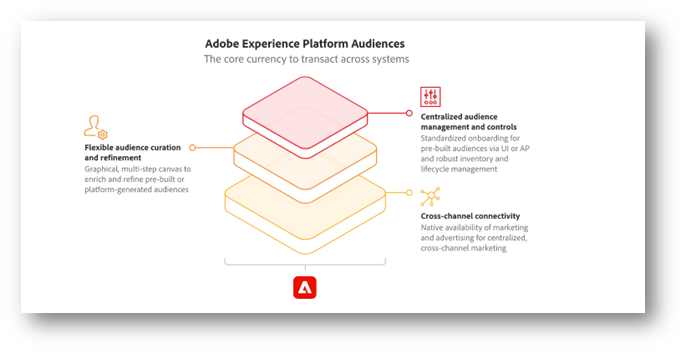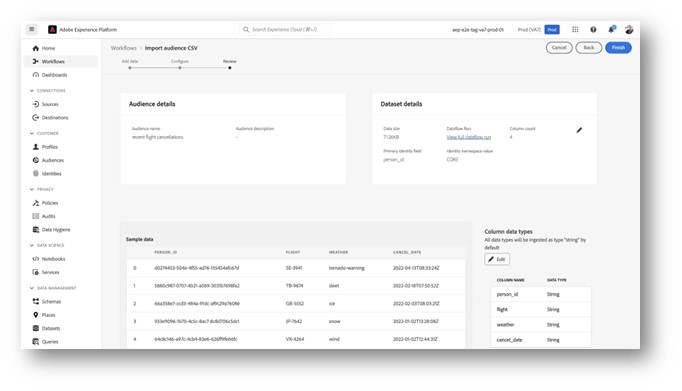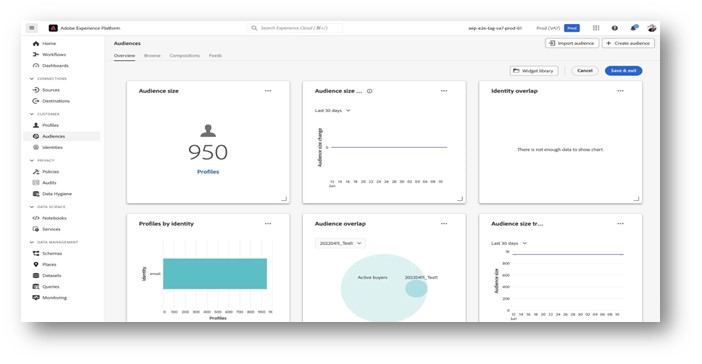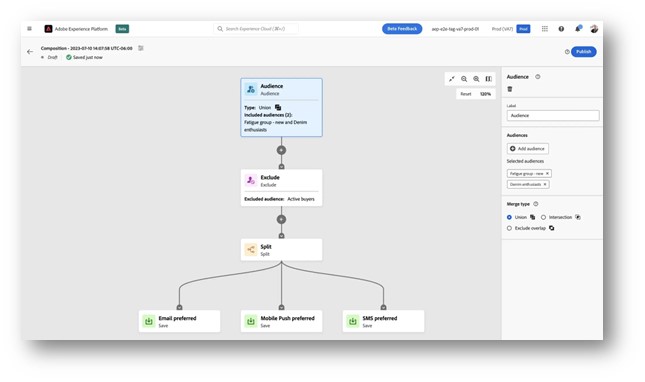Break down data silos with a new audience framework in Adobe Experience Platform and applications
October 5, 2023This article was originally published on Adobe website. Click here to see the original blog post.
Every business is looking to deliver exceptional customer experience to acquire new customers as well as retain existing relationships. Most organizations today use data to design an audience and then use that audience to personalize customer experiences across channels. According to IDC, customer experience is the first or second top investment area for digital leaders, with 78% stating customer data plays an extremely significant role in the customer experience.
But how does leveraging customer data to design an audience for personalization happen in practice? Often, this means a multi-step and cumbersome process. It might look something like this:
- Identify valuable datasets across an enterprise. This might be a mix of raw data or pre-defined segments.
- Determine how to gain access to each of these myriad data sources and segments.
- Configure multiple data source integrations.
- Attempt to mix and match this data together using logic to segment customer data — sometimes rebuilding pre-existing segments.
- Define an audience to personalize for a specific personalization campaign goal.
- Activate the audience across channels.
This complicated process, representing just one singular initiative within an organization, likely represents weeks if not months of work. Bear in mind, that would need to be repeated per initiative. Unfortunately, some of this work is repetitive in nature — like rebuilding segments that already exist and piecing together data due to systems that don’t integrate with one another or that are managed by separate teams. The key issue that brands are faced with is data silos. In the Future of Enterprise Resiliency and Spending Survey, IDC found that organizations have a less than 50% success rate at breaking down silos. It’s silos that get in the way of quickly creating smart audiences to fuel personalization at scale.
A new audience framework

To combat these data silos, improve user experience, and deliver more value for our customers, we’re re-envisioning the audience creation process inside of Adobe Experience Platform and applications such as Adobe Real-Time Customer Data Platform and Adobe Journey Optimizer. Specifically, we are introducing audiences as a core currency to transact across systems.
The newly reimagined Experience Platform audiences framework uses a centralized and standardized approach to provide support to the enterprise. This framework consists of three pillars:
- Centralized audiences — standardized onboarding for prebuilt audiences via UI or API and robust inventory and lifecycle management.
- Flexible audience curation and refinement — graphical, multi-step canvas to enrich and refine prebuilt or Platform-generated audiences.
- Cross-channel connectivity — native availability of marketing and advertising for centralized, cross-channel marketing.
Introducing new capabilities
Today users of applications built on Experience Platform, such as Real-Time CDP and Journey Optimizer, make use of business-critical audience tools. These include a workspace to build rule-based segments, different segment evaluation types, including streaming and edge segments, as well as a multi-entity segmentation and Segment Match, a data collaboration tool.
Now, we’re expanding on this set of capabilities with new innovations that unlock efficiency and interoperability across the enterprise.
Ingest new pre-defined audiences

Customers can now ingest pre-defined audiences from other sources, both from Adobe or non-Adobe products, eliminating the need for re-work and driving interoperability with disparate systems. These pre-defined audiences can be ingested directly into the UI and could consist of a range of different manipulations such as model output, list cuts for email, or just pre-defined logic from another system. In this workflow, customers can preview data in advance and then select which identity to key the audience off of. This pre-defined ingestion capability dramatically reduces manual efforts to re-create existing valuable audiences within activation-focused platforms and lets practitioners use re-gained time on more strategic audience work. This new approach successfully breaks down disruptive data silos and allows teams to work as efficiently as possible across disparate technology systems.
A comprehensive audience creation and management experience

This new, centralized management experience serves as a portal to audiences for the enterprise. Customers can now use a browse page that includes a new dashboard with segment trends and overlaps to find new insights and explore new organizational tools for foddering and tagging. Embedded within this new experience are governance controls for standardized audience labeling as well as audience lifecycle management capabilities to manage activation workflows. With this new management experience, customers can now easily and securely manage audiences for the enterprise from one place.
Composition canvas

As a complement to our Rule Builder, users now have the ability to curate audiences. Users can merge, split, and rank audiences in a multi-step intuitive process. As part of the composition, customers can now enrich audiences with additional data attributes to enhance 1:1 personalization. These capabilities, in coordination with a marketer-friendly canvas and Rule Builder, allow customers to build journeys for curated audiences for activation across destinations and channels.
Use audiences to create business impact
In today’s climate, most marketing and technology teams are feeling overburdened, under-resourced, and overwhelmed by the onslaught of customer data. With these new audience enhancements, we’re flipping this mindset on its head. With these new capabilities, we’re helping customers break through silos and leverage system interoperability for maximum efficiency. What’s more is that thanks to this brand-new audience toolset, we’re giving time back to practitioners by removing manual activities and allowing them to refocus on audience strategy. Now brands can make use of their customer data in a coordinated and streamlined way — with the all-important audience — to deliver meaningful, personalized customer experiences at scale.
Nina Caruso is a senior product marketing manager on the Adobe Real-Time Customer Data Platform product marketing team. Prior to her role in product marketing, she led a consulting team at Adobe focused on data management technical implementations. Caruso is experienced in data management implementation design, audience strategy, and personalization best practices.


